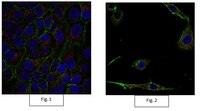MAB1501-AF555 Sigma-AldrichAnti-Actin Antibody, clone C4, Alexa Fluor® 555 Conjugate
This Anti-Actin Antibody, clone C4, Alexa Fluor® 555 Conjugate is validated for use in Immunocytochemistry for the detection of Actin.
More>> This Anti-Actin Antibody, clone C4, Alexa Fluor® 555 Conjugate is validated for use in Immunocytochemistry for the detection of Actin. Less<<Recommended Products
Přehled
| Replacement Information |
|---|
Tabulka spec. kláve
| Species Reactivity | Key Applications | Host | Format | Antibody Type |
|---|---|---|---|---|
| H | ICC | M | AlexaFluor®647 | Monoclonal Antibody |
| References |
|---|
| Product Information | |
|---|---|
| Format | AlexaFluor®647 |
| Presentation | Purified mouse antibody conjugate in buffer containing PBS, 15 mg/mL BSA, and 0.1% sodium azide. |
| Quality Level | MQ100 |
| Physicochemical Information |
|---|
| Dimensions |
|---|
| Materials Information |
|---|
| Toxicological Information |
|---|
| Safety Information according to GHS |
|---|
| Safety Information |
|---|
| Storage and Shipping Information | |
|---|---|
| Storage Conditions | Stable for 1 year at 2-8°C from date of receipt. |
| Packaging Information | |
|---|---|
| Material Size | 100 µL |
| Transport Information |
|---|
| Supplemental Information |
|---|
| Specifications |
|---|
| Global Trade Item Number | |
|---|---|
| Katalogové číslo | GTIN |
| MAB1501-AF555 | 04055977182033 |
Documentation
Anti-Actin Antibody, clone C4, Alexa Fluor® 555 Conjugate MSDS
| Title |
|---|
Anti-Actin Antibody, clone C4, Alexa Fluor® 555 Conjugate Certificates of Analysis
Technical Info
| Title |
|---|
| Characterization of Estrogen Receptor α Phosphorylation Sites in Breast Cancer Tissue Using the SNAP i.d® 2.0 System |
| White Paper: Further considerations of antibody validation and usage. |








